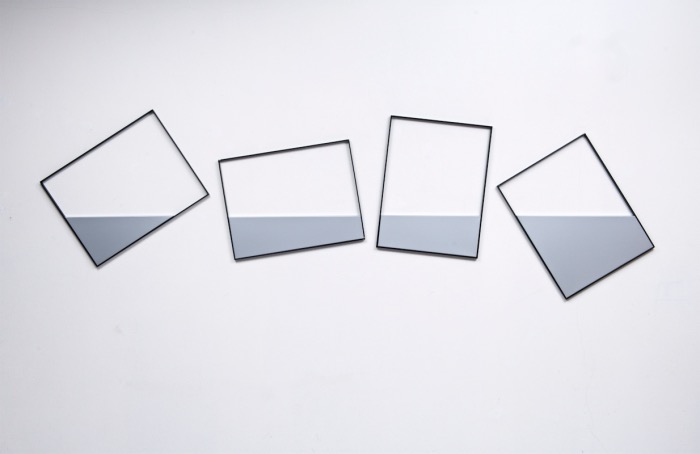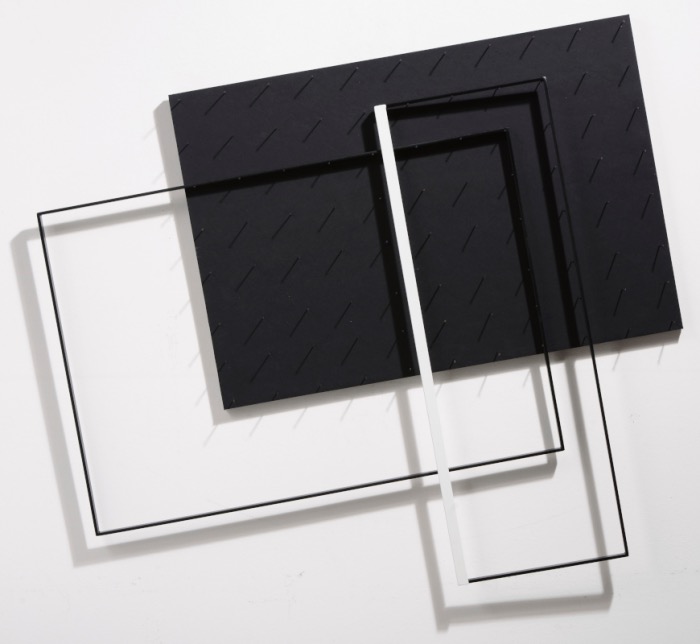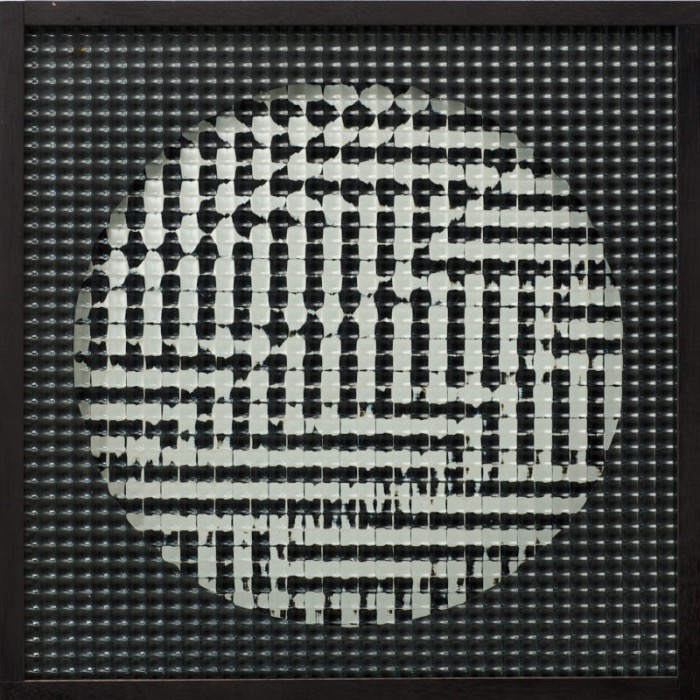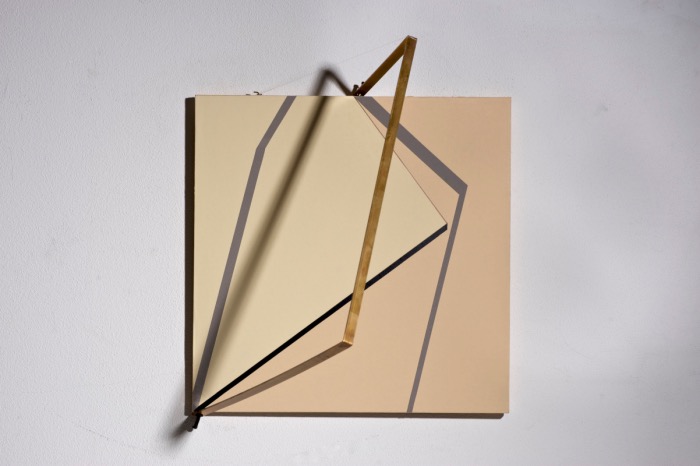
Quadri comunicanti, 2008, quattro elementi in ferro e alluminio, 64 × 49 cm l’uno
PERCEPTIVE SENSITIVITIES IN THE WORKS OF GRAZIA VARISCO
Grazia Varisco’s works are fundamental to the development of kinetic and programmed art.
Since her early days, when the artist joined Gruppo T in Milan in the early 1960s, she has been interested in the themes of perception and experimentation.
“In my experience ‘chance’ creeps, like a confused tangle, between probability and doubt. Chance’ avoids, attempts to dodge ‘chaos’ and settle in space and time, ignoring the rule that demands precision, regularity, orthogonality, order, chronological sequence. My ‘If…’, doubtful, lurks in the fold of the page that by ‘chance’ disrupts the rule that in typography and bookbinding cages everything in normality”.
With these words, Grazia Varisco presents the contents of her research. In this post we discover her works.
The works of Grazia Varisco

Spazio potenziale, 1976, legno, cartoncino nero, chiodi di acciaio, telai in ferro nero e
bianco, 39 × 59 cm
Grazia Varisco was born in Milan on 5 October 1937.
She attended the Brera Academy of Fine Arts in the second part of the 1950s, becoming a pupil of Achille Funi.
The 1960s marked the beginning of her career, characterised by experimentation and links with the most important artists of the time.
The Materici (1957-1959) are the first works from the 1950s made during his studies at the Brera Academy of Fine Arts, as experiences of reaction to figurative art.
The Magnetic Tables (1959-1962), on the other hand, are the works that represent the first research related to the formation of Group T. These works highlight the attention devoted by the artist to the representation of space-time and his strong interest in the elements of chance.
Since 1960, she has been active in artistic research as an exponent of Gruppo T with Giovanni Anceschi, Davide Boriani, Gianni Colombo and Gabriele Devecchi, participated in the Miriorama events, programmed art exhibitions and those of the Nouvelle Tendance
Nouvelle Tendance movement, with opportunities to meet and exchange with artists from
Italian and foreign groups animated by interests in the field of perception and
experimentation.
The Gruppo T experience soon came to an end, but Grazia Varisco continued her experimentation and exhibition activity independently.
She carried out an intense activity as a graphic designer for the Rinascente Development Office, for the magazine ‘Abitare’ and for Kartell.
In 1969 and 1973, during several stays in the United States, he met and frequents artists and professors from the Departments of Fine Arts, maintaining relationships that contributed to his education.
These years were characterised by a great creative drive.
In the Reticoli frangibili, the Mercuriali, the Variabili + Quadrionda, created between 1965 and 1971 Grazia Varisco uses industrial glass and its properties of refraction and deformation. Her works become an instrument for deforming reality as the image changes with every movement of the observer.

Variabile + Quadrionda 130, Scacchiera nera, 1964, legno, vetro industriale, motore
elettrico, 54,5 × 54,5 cm
Grazia Varisco’s works from the 1970s are characterised by reflections on the theme of chance and the uncalculated event as an element of investigation.
In the series Extrapagine (1973-1986), Spazio potenziale (1974-1976), Meridiana (1974) and Gnomoni (1975-1982) it is the anomaly that is the protagonist.
The unexpected collides with programming and spontaneously proceeds towards the experience of three-dimensionality.
From 1979 -1980 he engaged in teaching activities and from 1981 to 2007 she held the chair of Theory of Perception at the Brera Academy of Fine Arts in Milan from 1981 to 2007.
He took part in important national and international exhibitions including: Quadriennale in Rome, 1965, 1973 and 1999; Trigon in Graz, 1977; Arte italiana 60/82 at the Hayward Gallery in London, 1982; Electra at the Musée d’Art moderne de la Ville de Paris, 1983; Beyond Geometry at the Los Angeles County Museum and the Miami Art Museum, 2004; and many others.
The 1980s and 1990s saw Grazia Varisco’s works become increasingly abstract and essential.
The artist’s works accommodate the space without cluttering it, posing as unexpected elements that invite the visitor to reflect on the perception of fullness and emptiness.
He participated three times in the Venice Biennale: in 1964, 1986 and 2022.
On these three different occasions he presented the Variable Luminous Schemes (1962-1969) in which the artist experimented with materials completely unrelated to artistic production, such as blue methacrylate, electric motors and neon light, to create images in continuous variation.
In the new millennium, Grazia Varisco’s works explore the change and ambiguity of perception, involving the viewer in a continuous dialogue between programming and randomness.
Her works can be found in museums and public and private collections in Italy and abroad, including the Collezione Farnesina, the Collezione dell’Accademia di San Luca and the Galleria Nazionale d’Arte Moderna e Contemporanea in Rome, the Museum of Modern Art in New York, MAMbo in Bologna, the Centre Georges Pompidou in Paris, the Museo della Permanente, the Fondazione Prada, the Gallerie d’Italia and the Museo del Novecento in Milan and many others.
In 2017, the Milan Triennale dedicated a tribute exhibition to her.

Meridiana 2 (da Meridiana in nove versioni), 1974, legno, collage di cartoncini, porzione
di perimetro mobile in ottone, 50 × 50 cm
THE WORKS OF GRAZIA VARISCO ON SHOW
Grazia Varisco, just back from her participation in the Venice Biennale 2022 in the Central Pavilion and from a recent anthological exhibition at Palazzo Reale in Milan, presents a small but valuable exhibition of seventeen works that cover the entire span of her career, from the late 1950s to 2009, in a path in which the individual works form a unified body, while each one conserving its own originality.
Grazia Varisco. Perceptual sensibilities
Biscozzi Foundation | Rimbaud, piazzetta Baglivi 4, 73100 Lecce
9 October 2022 – 8 January 2023
Opening hours
Tuesday to Sunday from 4pm to 7pm; the last Sunday of each month
from 10 a.m. to 1 p.m. and from 4 p.m. to 7 p.m.

